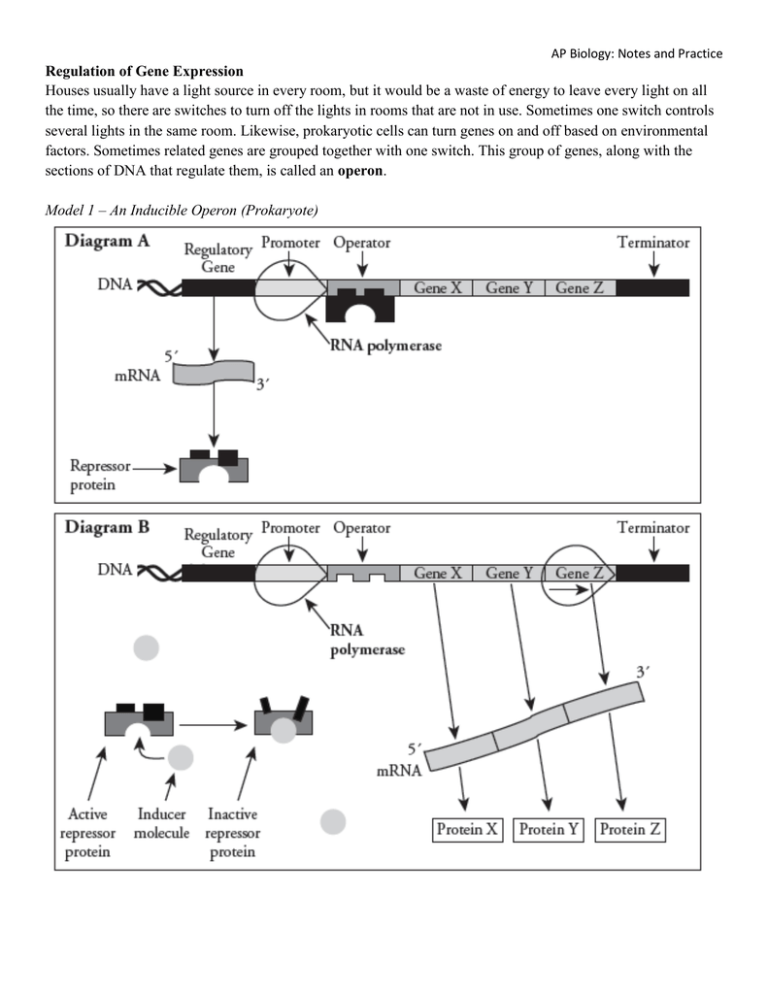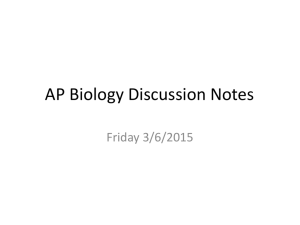Gene Expression Regulation: Notes & Practice (AP Biology)
advertisement

AP Biology: Notes and Practice Regulation of Gene Expression Houses usually have a light source in every room, but it would be a waste of energy to leave every light on all the time, so there are switches to turn off the lights in rooms that are not in use. Sometimes one switch controls several lights in the same room. Likewise, prokaryotic cells can turn genes on and off based on environmental factors. Sometimes related genes are grouped together with one switch. This group of genes, along with the sections of DNA that regulate them, is called an operon. Model 1 – An Inducible Operon (Prokaryote) AP Biology: Notes and Practice 1. Describe what an operon is and provide a “real-world” operon example, different than the one provided in the passage. 2. Consider the operon in Model 1. Other than the gene that regulates the operon, how many genes are contained within the operon? 3. Refer to diagram A in Model 1. What protein does the regulatory gene in Model 1 produce? 4. Refer to diagram B in Model 1. a. When an inducer molecule attaches to the repressor protein, what happens to the repressor protein? b. How does the change identified in part a affect the function of the repressor protein (identified in 2b)? 5. Consider the non-science meaning of the following terms. Match the purpose with each of these sections in the operon in terms of gene transcription. Explain your reasoning for each match. Promoter Operator Terminator Repressor Protein Spot where transcription ends Spot where transcription begins On/off switch Binds to the operator, blocking RNA polymerase from transcribing genes 6. In which diagram of Model 1 is transcription and translation occurring successfully for the genes listed in question 2? Justify your answer with evidence from Model 1 and propose an explanation as to why these processes can occur. AP Biology: Notes and Practice 7. The lac operon in E. coli is an example of an inducible operon. It codes for several genes that produce proteins that are necessary to metabolize (digest/break down) lactose when it is present in the cell’s environment. Lactose acts as the inducer. a. If there is a low amount of lactose present in a cell, do the genes of the lac operon need to be transcribed, translated, transcribed AND translated, or none of these? Explain your reasoning. b. If there is a high amount of lactose present in a cell, do the genes of the lac operon need to be transcribed, translated, transcribed AND translated, or none of these? Explain your reasoning. c. Describe how the binding of RNA polymerase and the repressor protein to the operon will differ if there is high lactose in a cell versus if there is low lactose in the cell. (It may be helpful to draw a diagram!) Explain your reasoning. AP Biology: Notes and Practice Model 2 – A Repressible Operon (Prokaryote) 8. Refer to diagrams A and B in Model 2. a. Compare the function of the repressor protein when a corepressor is present to when a corepressor is absent. b. Describe the structural changes that take place in the presence/absence of a corepressor molecule and explain how these changes cause the difference in the active state of the protein? AP Biology: Notes and Practice c. How is a corepressor different from an inducer? 9. The trp operon in E. coli is an example of a repressible operon. The group of genes contained in this operon helps the organism produce the amino acid tryptophan from other compounds when tryptophan is not present in the cell. a. If there is a low amount of tryptophan present in a cell, do the genes of the trp operon need to be transcribed and translated? Why or why not? b. If there is a high amount of tryptophan present in a cell, do the genes of the trp operon need to be transcribed and translated? Why or why not? c. Describe how the binding of RNA polymerase and the repressor protein to the operon will differ if there is high tryptophan in a cell versus if there is low lactose in the cell. (It may be helpful to draw a diagram!) Explain your reasoning. AP Biology: Notes and Practice 10. Galactose is a monosaccharide that is used to build prokaryotic cell walls. The gal operon of E.coli contains a regulatory gene that produces a repressor protein, an operator (OE), and one structural gene (galE). The OE operon is unique in that it comes before the promoter. When a repressor protein is bound to this operator it inhibits binding of RNA polymerase to the promoter, thereby inhibiting transcription. The galE gene codes for a protein that converts extra glucose in the cell into galactose to build cell walls. The structure of this operon is shown below. Regulatory Gene (for OE) Operator (OE) Promoter galE Use the following key to create your drawings for parts b and c. RNA Polymerase Repressor Protein Glucose a. When E. coli is in high-glucose conditions, glucose will bind to the repressor protein produced by the regulatory gene for OE. According to the information in the passage and your knowledge of operons, does glucose binding cause the repressor protein to bind to the OE operator or detach from the OE operator? Explain your reasoning using the new information and including what type of operon OE is. b. Draw the interactions of the molecules in the key with the operon when the cell has a high amount of glucose. Explain your reasoning. c. Draw the interactions of the molecules in the key with the operon when the cell has a low amount of glucose. Explain your reasoning. AP Biology: Notes and Practice Model 3 – Eukaryotic Gene Control Eukaryotes, as multicellular organisms, are significantly more complex than prokaryotes. Prokaryotes evolved to grow and divide rapidly (and therefore need to turn genes on or off quickly), but eukaryotic growth and development is a long-term process. Because the actions of one cell in a eukaryote can directly affect the function of another cell in that organism, “switching” a gene on or off must be coordinated by many cells working together. This coordination occurs through signal transduction pathways, which are as varied as the species on Earth, but each of them follow the same basic steps. Reception may occur by a ligand (messenger molecule produced by another cell) attaching to a receptor protein or the ligand may travel through the cell membrane by diffusion. Transduction may occur by one protein or by several proteins activating each other in a cascade. 11. Phosphorylation is a process that occurs during transduction. It adds a phosphate group (from ATP) onto proteins called protein kinases to “activate” it-that is, to change its shape so that it can function properly. What process is this similar to in gene regulation in prokaryotes? Explain your reasoning. 12. Refer to Model 3. Describe the event that sets off a phosphorylation cascade inside of a cell. AP Biology: Notes and Practice 13. What is the final protein the cell appears to activate in this pathway and what does that protein appear to do? 14. When the protein identified in question 13 binds to DNA in a eukaryotic cell, RNA polymerase is then able to bind to DNA. What process will likely occur next? Explain your answer. 15. The Wnt protein plays a critical role during a certain period of embryo development, but it normally has no role in adults except for the maintenance of adult stem cells. However, high levels of Wnt protein have been found in a large number of patient prostate cancer samples. The two figures below display the cell signaling pathway in the presence and absence of Wnt. Axin, APC, GSK38, and CK1 are all protein kinases involved in signal transduction for this signaling pathway. B-catenin is a transcription factor. Wnt Present Wnt Absent Inhibited Axin Axin GSK38 CK1 APC APC GSK38 CK1 B-catenin B-catenin B-catenin Nucleus Transcription Nucleus a. Predict whether Wnt is a hydrophobic or hydrophilic molecule. Explain your answer. b. Compare and contrast the events that occur in a cell in the presence and absence of Wnt. AP Biology: Notes and Practice c. One approach to treating patients with prostate cancer and other cancers in which the Wnt protein is detected is to modify the Wnt signaling pathway. Propose which of the following treatments (there may be more than one) would be most useful using this approach. Explain your reasoning. Treatment A B C D E F Action Inject high concentration of B-catenin into cells Dose patients with a drug that acts as a competitive inhibitor of Wnt Inject patient with embryonic stem cells Treat patient with protein BMAL 1, increasing the dissociation of CK1 from the intracellular protein complex Phosphorylates B-catenin, preventing its dissociation from the intracellular protein complex Inject high concentrations of cadherin, a protein complex containing B-catenin d. Which treatments listed in part c could possibly increase the aggressiveness of prostate cancer? Explain your reasoning.


